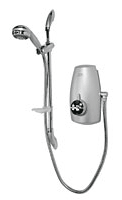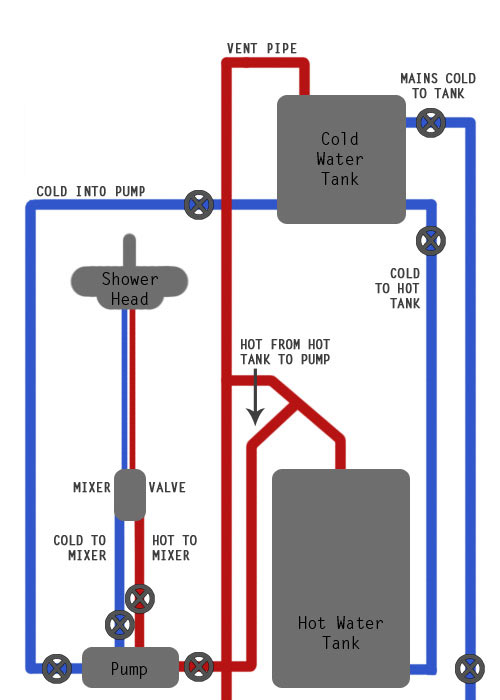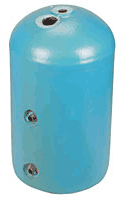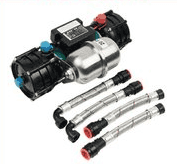Warning: To complete electrical works you must comply with Electrical Regulations – Click here for more information.
A shower which uses a pump to push water out as fast as possible is called a power shower. There are two kinds of power shower. The first is a shower with a pump built into it as a complete unit and the second a shower which has a separate pump in the system. Both are good but the power shower with the integral pump is probably a little easier to fit for the DIY enthusiast. The shower shown below has an integral pump

Power shower with integral pump
Not all homes can have a power shower immediately. A power shower takes both hot and cold water from a tank and pumps it out. Some homes do not have a hot tank and some do not have a cold tank. Some homes don’t have either. This is not to say that tanks cannot be fitted to enable a power shower to be installed but this makes the fairly simple task of adding a shower into a very much more difficult and expensive one. There are other options.
To understand fully how your domestic hot water system works see our domestic hot water systems information project or to understand more about cold water systems see our cold water systems information project.
Ideally your power shower would be a concealed shower with the minimum of pipework showing.
Assuming then that you are able to have a Power shower, this project will deal with the installation of a separately pumped shower. A power shower with an integral pump uses both hot and cold water as shown in the diagram but does not need the pump shown in the diagram. All power showers use a mixer valve to mix the water to the required temperatures. There are many kinds of mixer valves and these are dealt with in a separate project.
The water from the mains goes into the cold tank in the loft. Other loft tank feeds cold water into the hot tank in the airing cupboard. The cold water goes into the bottom of the hot tank and as it is heated it rises to the top where it is drawn off by taps, showers etc. You can see from the diagram the hot and cold water come from their tanks into either side of a twin impeller pump. As you might imagine this means the pump has two inlets and two outlets. (Impeller means a mechanism for driving forwards). The black circles with crosses in them on the diagram are on/off valves which will isolate different parts of the system.

Diagram of a seperate pump for power shower
Separate, single impeller pumps are available for power showers but these have to be fitted between the mixer valve and the shower head. The mixer valve mixes the water temperature and its then pumped to the shower head. Having a twin impeller pump means the water gets to the mixer under pressure. Shower pumps are made with varying power. The power is measured in bars. Water comes to your house, via the stop cock, at a minimum pressure of 1 bar and is usually measured at the stop cock at between 2 and 4 bars. The more bars you have, the faster the water comes out. Check with the manufacturer whether the pressure you require is available with a) the pump you buy and b) the mixer valve you buy.
If you had a tank full of water 10m up in the air with a pipe coming down to the ground which had a tap on it. The pressure at that tap would be 1 bar. This is how bars are measured. If your cold water tank is 2m above your cold water tank in the bathroom (and it is not pumped) the water pressure at this tap would be 0.2 bars. A good water pressure, combined with a good flow, gives a good shower. Providing your supply is adequate, I.E. the tank holds enough water, you should use 22mm pipework with a 2 – 3 bar shower pump to achieve the best results. It is said that the best flow rate for a power shower is about 15 litres per minute. A 5 minute shower will therefore use 75 litres which is a lot of water so make sure you have the correct sized tanks for a set up like this. A large electric shower, say 10kW will deliver about 5 liters per minute. A minimum cold water tank size of 115 liters or 25 gallons is recommended. The manufacturers instructions with the pump will tell you how many litres per minute the pump is expected to move and the minimum size of tank you should have.

Hot water tank

Twin impeller pump
The pump is best sited under the water tank and will ideally be placed on a rubber or cork shock absorber under each part that touches the structure of the floor. The more powerful the pump, the greater the vibration and without insulation a lot of pumps can be heard all over the house!
Obviously a shower pump needs electrical connections and care needs to be taken when working with electricity. The safest installation is to install a switched, fused spur from your ring main, in the airing cupboard so the pump can be turned off quickly and easily. Please see our project on electrical safety and regulations for more help and advice.

